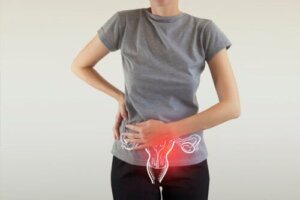What is Ovarian Torsion and How Is it Treated?


Written and verified by the doctor Mariel Mendoza
Ovarian torsion occurs when one of the two ovaries twists on the ligaments that hold it in place. This twisting causes an interruption of blood flow to the organ and even to the fallopian tube, with a consequent decrease in tissue oxygenation.
The main symptom of ovarian torsion is severe lower abdominal and pelvic pain, vomiting preceded by nausea, abnormal uterine bleeding, and sometimes even a fever. It is more frequent on the right side because the left ovary is held in a stable position by the bowel.
This is a medical emergency that requires immediate attention. Its resolution is only surgical. That is why it’s necessary to know how to recognize it in time.
How does ovarian torsion present itself?
In ovarian torsion, pain tends to be sudden and intense. However, it may be intermittent and due to alternating periods of torsion and detorsion of the organ.
It hardly ever occurs without pain.
The pain usually manifests in the lower abdominal and pelvic area, and even on the side of the affected ovary. In addition, it may cause vomiting preceded by nausea, a fever, and abnormal uterine bleeding.
If ovarian torsion is sustained over time, it can cause tissue death due to oxygen deficiency (ischemia and subsequent necrosis), leading to loss of ovarian tissue and function. Rarely, the area may become infected and the infection spreads throughout the abdomen.
Diagnosis is important because the symptoms can be confused with other conditions:
- Appendicitis
- Kidney stones
- Urinary tract infection
- Gastroenteritis

We think you may be interested in reading this, too: Ovarian Dermoid Cysts: Symptoms and When to See a Doctor
Epidemiology
Ovarian torsion is most common between the second and fourth decades of life. It does not usually occur before puberty or after menopause.
Causes
Although there is no specific cause, there are associated risk factors. The presence of a cyst, tumor, abscess in the ovary and fallopian tube or other mass in the ovarian tissue can increase the risk of ovarian torsion.
Because the extra weight allows the organ to rotate on itself and its supporting ligaments, up to 80% of cases present with an ovarian cyst or mass, especially if it’s larger than 5 cm. Sometimes, in addition to the ovary, the fallopian tube as a whole can be twisted.
It may also be due to the fact that the ligament that joins the ovary to the uterus is more lax than normal, making it easier to mobilize. Associated with increased ligament laxity is induced ovulation in assisted reproductive treatments, polycystic ovarian syndrome, hormone replacement therapy, and pregnancy.
High hormonal loads can relax the tissue, making it more prone to ligament torsion.
Because there is an obstruction of blood flow, ovarian torsion is a medical emergency. A history of tubal ligation is also a risk factor.
Like this article? You may also like to read: Ovulatory Dysfunction: What Is it and How to Deal with It?
Diagnosis
Diagnosis of ovarian torsion begins with questioning and a physical examination. Vaginal and abdominal ultrasounds are used for imaging studies.
If the condition is not evident, a CT scan or an MRI may be indicated. In addition, complete hematology is requested to evaluate the presence of a possible infection.
The definitive diagnosis of ovarian torsion is visualization through surgery.
The only treatment is surgery
The only definitive diagnostic method and treatment is surgery. However, prior to this an approach to reduce pain and nausea may be indicated.
Among the analgesics the following are preferred:
- Acetaminophen
- Ibuprofen
- Naproxen
- Opioids, in cases of more severe pain
Surgery should be performed as soon as possible to avoid ischemia and tissue necrosis. The procedure for ovarian torsion can be by laparoscopy (an endoscopic surgery) or laparotomy (an open surgery).
During surgery, the ovary is visualized to determine if it has sufficient blood flow. If it shows signs of ischemia, the entire ovary must be removed. Sometimes, in addition to the removal of the ovary, the removal of the fallopian tube on the same side may be required.
In cases where there is no tissue involvement, it’s sufficient to simply untwist the ovary and assess the blood flow to the ovary. Postoperatively , high doses of contraceptives are indicated to reduce the risk of recurrence.

Ovarian torsion requires immediate action
Ovarian torsion is a very rare condition, but it’s a cause to be taken into account in cases of sudden abdominal pain in women. This is especially the case for women of childbearing age.
It’s a medical emergency because it can lead to ischemia and necrosis of ovarian tissue, with its subsequent loss. However, it’s important to note that in case of losing an ovary, fertility will not be affected, since the other organ is capable of covering the body’s needs.
All cited sources were thoroughly reviewed by our team to ensure their quality, reliability, currency, and validity. The bibliography of this article was considered reliable and of academic or scientific accuracy.
- American College of Obstetricians and Gynecologists Committee. Adnexal torsion in adolescents: ACOG Committee Opinion No, 783. Obstet Gynecol. 2019;134(2):e56-e63.
- Huang C, Hong M, Ding D. A review of ovary torsion. Ci Ji Yi Xue Za Zhi. 20017;29(3). Disponible en https://pubmed.ncbi.nlm.nih.gov/28974907/.
- Lasso C, et al. Torsión ovárica. Evolución del ovario necrótico tras detorsión laparoscópica. Cir Pediatr 2014;27. Disponible en https://secipe.org/coldata/upload/revista/2014_27-1_26-30.pdf.
- Sasaki KJ, Miller CE. Adnexal torsion: review of the literature. J Minim Invasive Gynecol. 2014;21(2):196-202.
- Wang Z, Zhang D, Zhang H, et al. Characteristics of the patients with adnexal torsion and outcomes of different surgical procedures: a retrospective study. Medicine. 2019;98(5):e14321.
This text is provided for informational purposes only and does not replace consultation with a professional. If in doubt, consult your specialist.








